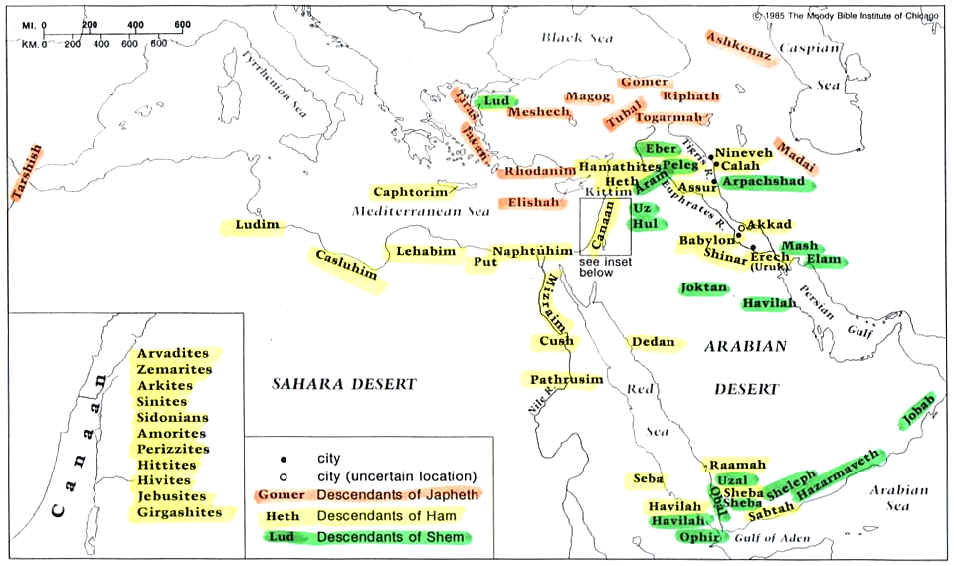Genesis 10-11
Introduction
 This lesson studies the early genealogies after the Great Flood. It focuses on key points such as the Table of Nations and the Tower of Babel, and names such as Magog and Nimrod.
This lesson studies the early genealogies after the Great Flood. It focuses on key points such as the Table of Nations and the Tower of Babel, and names such as Magog and Nimrod.
Gen. 10
Gen. 10 details the expansion of the human race after the Great Flood. The reason this information is important is because scripture refers back to it in historical and prophetic passages, so we should be familiar with key names and places. God had commanded people to multiply and cover the earth, and this is the account of how that began.
But before we look at the Table of Nations, one issue needs to be clarified: the meaning of the Greek word ethnOn, which the parallel I’ve been using renders as Gentiles. In the NT the context always tells us that it refers to all who are not Jews, hence the translation Gentiles. But this has no meaning before Israel as a nation existed, so before Abraham at least, the literal meaning nations should be used.
Take a moment to study this Table of nations document, and notice some of the key names and concepts. Nimrod is the first person scripture cites as having a kingdom, and he tried to prevent the spread of people over the earth to consolidate his power. But was Nimrod said to have become a giant; is that a physical giant, or just a human tyrant? There are 3 points to consider in answering that question, as posed by this source:
- Nimrod became a giant, so how could it refer to his body size?
- Gen. 6 says the giants’ fathers were fallen angels.
- Nimrod descended from Cush, not fallen angels.
Now there is ample historical evidence that physical giants have existed. However, Greek mythology describes them as having super-human strength, but not always super-human size. Either way, there would be no reason for only one line of people to produce ordinary human tyrants. Yet all the physical giants were also tyrants, and it’s reasonable to conclude that in time the word for physical giants came to just mean powerful tryants of any size.
Now let’s look at this source: The hunter becoming king
is a common pattern in history, likely after Nimrod’s example. All things considered, the context paints a picture of the first world tyrant defying God, not that he was a physical giant.
As for Magog, that is covered in the study of Ezekiel 38 regarding a once and future enemy of God and the Chosen People.
Gen. 11
As we move on to ch. 11, we come to the account of the Tower of Babel. Most researchers see evidence that the instigator of this project was in fact Nimrod. This was a defiant gesture against God, not only to prevent the spread of the population over the earth, but also to set up a world government. Some speculate that it was meant to literally reach the sky so they could storm the abode of God and destroy him. But the text simply indicates that the purpose was to unify the world and keep everyone in one place. So God instantly created numerous languages to prevent the builders from communicating, and the project was abandoned. The Table of nations document includes a brief discussion (in the blue box near the end) of the secular evidence for such languages having their own origins, rather than all evolving from one source.
Before going on to vs. 12, study this chart regarding the corrected timeline of the descendants of Shem. Compare the Greek and Hebrew for that verse and following, and you’ll see the missing 100 years each from Arphaxad, Shelah, Eber, Peleg, Reu, and Serug.
The end of ch. 11 reports the death of Terah, father of Abram (whose name wasn’t changed to Abraham until later). This is the likely event God waited for before telling Abram to go to what would become known as the Promised Land, which we’ll study in the next lesson.

